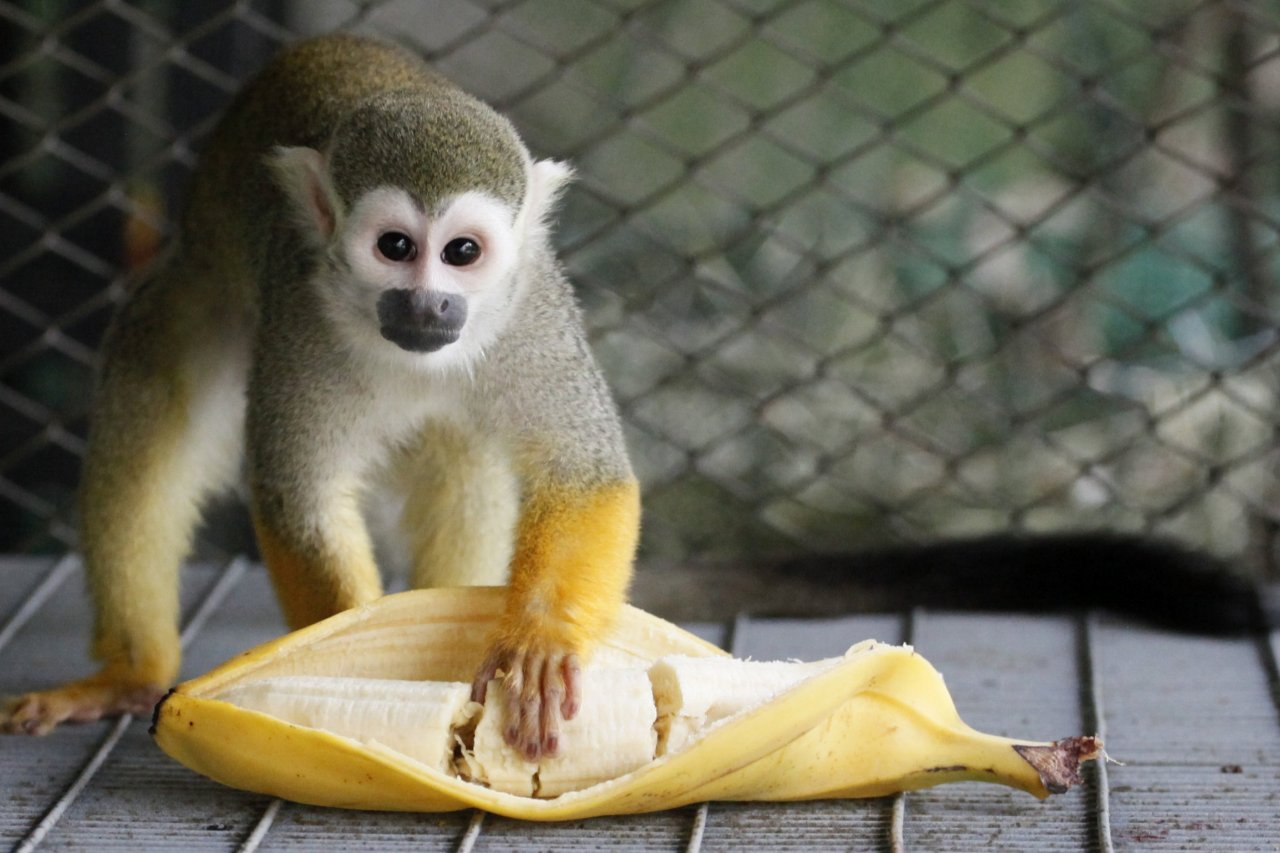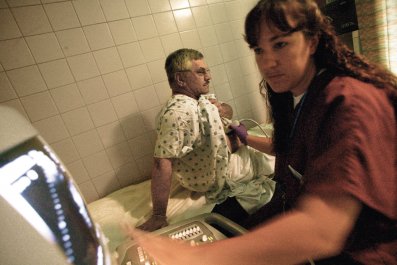We all know monkey see, monkey do. And Sam the squirrel monkey sees and does more than most. For one thing, he eats a wider range of food. He likes green vegetables—spinach and kale. True story: He used to avoid green foods. In fact, he sort of hated them.
Then scientists made Sam a health-junkie monkey.
Normally, male squirrel monkeys can't distinguish between red and green hues—they're what is called color-blind in humans. The South American Saimiri genus lacks a gene that allows color-sensitive cells in the eye, called cones, to differentiate red and green from gray. To these animals, other colors, such as blue, brown and orange, appear faded. But Sam was one of two males in the experimental group of a groundbreaking 2009 ophthalmological study conducted at the Washington National Primate Research Center in Seattle. Husband-and-wife vision researchers Jay and Maureen Neitz injected a viral vector behind the retinas, the part of the eye that responds to color, of Sam and his simian lab partner, Dalton. The virus contained the genetic code in human eyes for red pigment, giving the monkeys an extra class of cone photoreceptor.
Sam and Dalton were trained to "tell" researchers which colors they could see. They learned to find colored patches of dots on a background of gray dots. A computer touch screen was devised that allowed the animals to trace the color patterns. When they chose correctly, they were rewarded with grape juice. After 20 weeks, their color recognition skills improved dramatically.
Unlike every other male Saimiri sciureus, Sam now sees the full color spectrum. (Dalton, alas, died of old age.) "Sam seems to enjoy it," Jay Neitz says of the primate's Technicolor upgrade.
Last month, the Neitzes joined with Avalanche Biotechnologies in Menlo Park, California, to develop the first cure for color blindness in humans. Through gene therapy, they've found a new way to replace the proteins that are missing in the cones of the eyes of color-blind people. If all goes as planned, testing on humans could begin in a couple of years. "I don't think there's any question that it will work," says Maureen Neitz, who, like her husband, is a professor of ophthalmology at the University of Washington.
The Neitzes have been collaborating since 1986, when they both received their Ph.D.s from the University of California, Santa Barbara. They got interested in the genetics of eye disease during their post-doctoral studies. In 1989, Jay Neitz's research at Santa Barbara confirmed that dogs are color-blind. Two years later, he and Maureen Neitz hooked up with the Medical College of Wisconsin in Milwaukee and set upon developing a cure for the disorder.
Like tasting sourness or feeling softness, color is a sensation. The Neitzes weren't sure how the brains of color-blind male squirrel monkeys would react to sensations they hadn't ever previously registered. They were surprised to find that the animals had the neural pathways to make sense of the information—which meant that after the researchers gave them the new cone, the monkeys could see the same colors as non-color-blind primates. In 2009, Time magazine ranked the breakthrough third in its list of the year's top 10 scientific discoveries.
For humans, the Neitzes are considering a different technique, developed at the University of California, Berkeley: injecting genes into the vitreous, the clear, gelatin-like liquid that fills most of the eye. Thomas Chalberg Jr., the co-founder and chief executive of Avalanche, describes the treatment as a "protein shell, kind of like a Trojan horse that gets you entry into the cell." Once inside, "the DNA gets to set up shop and produce the photopigment of interest."
Some people have achromatopsia—they can't see any color at all. But it's very rare: one in every 33,000 people. Most people with impaired color vision don't differentiate between green and red. Facebook's logo is blue because co-founder Mark Zuckerberg is red-green color-blind, and he says blue is "the richest" color for him.
This congenital deficiency impacts more than 10 million Americans, most of them men: One in eight males is red-green color-blind. This is due to a trick of genetics: The two opsin genes that color-blind people lack are carried on the X chromosome. If you are female, you have two X chromosomes—in other words, you have a redundant pair of opsin genes if one set doesn't work. Men, though, have only one shot: If their X chromosome is faulty, they'll end up color-blind.
Sometimes, there are tragic consequences of color blindness, and Jay Neitz has seen them. One of his patients caused a fatal car accident because he couldn't see a flashing red light. Another was denied a lifelong dream of becoming an airplane pilot. In Romania and Turkey, the color-blind are prohibited from obtaining driver's licenses. In the past, full or partial color blindness was a disqualifying condition for service in the U.S. military. The condition is still an impediment to becoming a graphic designer, computer developer, police officer or pharmacist, among other professions.
Jay Neitz says his work with Avalanche means a cure for color blindness could be on the horizon. He dismisses the "revolutionary" eyewear on the market that's supposed to boost color vision, bringing color to the color-blind. He says the glasses are expensive (EnChroma sunglasses, for example, list for $440 each on Amazon) and don't really work. "Once every 10 years, pretty much like clockwork, someone invents glasses that cure color blindness," he says. "All of those glasses block out some part of the spectrum. You could put out glasses that would block out all green light, so the reds would be darker. A color-blind person would look through them and say, 'Oh, I'm cured.'"
Interest in the Neitz-Avalanche partnership has drawn more than 10,000 eyeballs to their website, ColorVisionAwareness.com, since its launch on March 25. But what really made Jay Neitz a social media sensation was The Dress. When the photo of the white-and-gold (or blue-and-black?) frock went viral on February 26, he "got a phone call every three minutes" asking him to explain the phenomenon, and he sarcastically told Vice: "I thought I was going to cure blindness, but now I guess I'll do this." The next day, his 26-year-old daughter told him, "Dad, you're trending."
Of course, some color-blind people don't want to be cured; they think the condition gives them an edge. The artist Mario Toscano is known for his paintings of hot-air balloons in New Mexico. He uses ocher and brick, a palette usually associated with a melancholy perspective, to depict vibrant reds and greens. When the Neitzes saw his work, they suspected color blindness. "Mario told us he'd been diagnosed as color-blind," says Jay Neitz, "but that he's happy with his artistic vision. I did not try to dissuade him. His paintings are amazing examples of the world through color-blind eyes."
A debate is raging in ophthalmological circles about adding colors to our vision. "What if someone invented a way to add even more—who wouldn't want it?" asks Jay Neitz. Besides red, green and blue cones, 12 percent of all women are believed to have a fourth cone in their retinas. The extra cone is usually nonfunctioning, but a very few women are tetrachromats, meaning they have an active fourth cone and can see another dimension of colors that other humans can't. In 2010, the first such woman was found during a British study on the mutation. She was tested by having a computer create a color visible only to tetrachromats.
This type of superhuman vision lets you see 100 million shades—about 100 times more than the rest of us. Since the 2010 study, more female tetrachromats have come forward, like Concetta Antico, an Australian artist based in San Diego, and New York journalist Maureen Seaberg. Antico, who paints nature in wild multi-hues, was the subject of a number of tetrachromacy studies at the University of California, Irvine. "The little stones jump out at me with oranges, yellows, greens, blues and pinks," she says. "I'm kind of shocked when I realize what other people aren't seeing." Ironically, Antico's daughter is color-blind.
The Neitzes have been approached about enhancing color vision in dogs, too. If Fido the Seeing Eye Dog could recognize more colors, he might better read red and green traffic signals. But the Neitzes are skeptical about whether gene therapy would take hold in pooches. "Their circuitry may prevent it," says Jay Neitz. "Even if dogs get the extra photopigment, they might not get the vision." Sam the squirrel monkey's unique circuitry made him an ideal guinea pig.



















